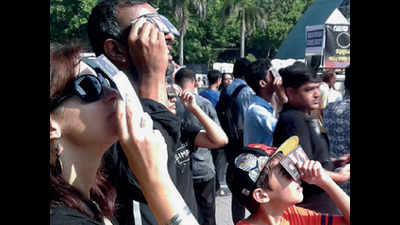- News
- City News
- lucknow News
- Lucknow: Astronomy buffs raring to view ‘necklace of pearls’
Trending
This story is from June 21, 2020
Lucknow: Astronomy buffs raring to view ‘necklace of pearls’

Photo used for representational purpose only
LUCKNOW: Astronomy buffs in the city are gearing up to witness the rare celestial event — the annular solar eclipse — on Sunday, but there won’t be the usual arrangements and crowd at the Indira Gandhi Planetarium this time due to Covid-19 curbs.
Rather for the first time, the Indira Gandhi Planetarium will live stream the celestial event for astronomy enthusiasts.

Solar eclipse takes place each year, but is not visible across globe.The next ‘ring of fire’ solar eclipse will be visible in India in 2031 while in the city it will be visible in 2034.
“In this eclipse, that ring is expected to be very thin as the Moon will cover up to 98.8% of the solar disc, making it the “deepest” annular eclipse of the century in India,” he added.
“In Lucknow, 84.24% of the sun will be hidden by moon from 12:11:15pm to 12:12:02 pm for 47 seconds,” said Srivastava.
The sun will appear like a necklace of pearls for around 30 seconds where full eclipse is visible, he added.
“We are not installing telescope at the planetarium for public viewing this time due to the pandemic, but will live stream it on YouTube channels ‘CSTUP’ and ‘UPASTROCLUB’. The link of live streaming will be made available on the website of Council of Science and Technolgy, Uttar Pradesh, said Srivastava.
“It is a wonderful opportunity to witness this rare celestial show from the comfort of one’s home via live streaming. The next annular solar eclipse will be visible in city after 14 years,” he added.
“Instead of a ring of fire, the Sun may appear as a necklace of shiny beads, known as Baily’s beads,” said a member of Scientific Knowledge for Youth Amateur club Swapnil Rastogi.
“If you want to witness the eclipse, do not look at the Sun directly as it could harm the retina of eye. It’s important to wear proper eye protection like goggles for looking directly at the Sun without damaging your retina,” he added.
Rather for the first time, the Indira Gandhi Planetarium will live stream the celestial event for astronomy enthusiasts.

Solar eclipse takes place each year, but is not visible across globe.The next ‘ring of fire’ solar eclipse will be visible in India in 2031 while in the city it will be visible in 2034.
“The annular solar eclipse occurs when the Moon comes in between the Sun and earth and blocks its view, and since the Moon is smaller and cannot cover it fully, a circular ring of Sun remains visible. It appears like a ‘ring of fire’ and is also called a necklace of pearls,” said scientific officer, Indira Gandhi Planetarium, Sumit Srivastava.
“In this eclipse, that ring is expected to be very thin as the Moon will cover up to 98.8% of the solar disc, making it the “deepest” annular eclipse of the century in India,” he added.
“In Lucknow, 84.24% of the sun will be hidden by moon from 12:11:15pm to 12:12:02 pm for 47 seconds,” said Srivastava.
The sun will appear like a necklace of pearls for around 30 seconds where full eclipse is visible, he added.
“We are not installing telescope at the planetarium for public viewing this time due to the pandemic, but will live stream it on YouTube channels ‘CSTUP’ and ‘UPASTROCLUB’. The link of live streaming will be made available on the website of Council of Science and Technolgy, Uttar Pradesh, said Srivastava.
“It is a wonderful opportunity to witness this rare celestial show from the comfort of one’s home via live streaming. The next annular solar eclipse will be visible in city after 14 years,” he added.
“Instead of a ring of fire, the Sun may appear as a necklace of shiny beads, known as Baily’s beads,” said a member of Scientific Knowledge for Youth Amateur club Swapnil Rastogi.
“If you want to witness the eclipse, do not look at the Sun directly as it could harm the retina of eye. It’s important to wear proper eye protection like goggles for looking directly at the Sun without damaging your retina,” he added.
End of Article
FOLLOW US ON SOCIAL MEDIA










